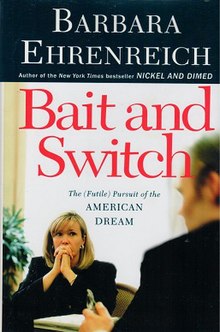內容簡介
每日一詞:Bait-and-switch,誘購。軟銀向初創企業巨額注資引發連鎖效應。這些企業用激勵措施來吸引承包商,但在沒有得到預期回報後又踢走了他們。 時報記者寫道 ,對那些遭受損失的承包商來說,這就像一種“bait-and-switch”。 Bait-and-switch一詞指以廉價商品、促銷活動等招徠顧客,再引誘他們為高價商品買單的誘售策略。
- 作者: (美)芭芭拉·埃倫里奇
- 出版社:中信出版社
- 出版日期:2006/10/01
- 語言:簡體中文
內容簡介
目錄
Bait and Switch (book)

First edition
| |
| Author | Barbara Ehrenreich |
|---|---|
| Publisher | Metropolitan Books |
Publication date
| United States 2005 |
| Pages | 256pp. |
| ISBN | 1429915706 |
Bait and Switch: The (Futile) Pursuit of the American Dream is a 2006 book by Barbara Ehrenreich.
Contents[edit]
The book follows Ehrenreich's examination of the world of insecure low-wage work that constituted Nickel and Dimed, published in 2001. In this case, she decided to pseudonymously penetrate the corporate world instead and then write about the way in which things operate in reality in a similar manner to her earlier book (in this case adopting her maiden name as a cover). She embarked upon a quest to try to get a job in public relations.
However, after ten months of effort (including hiring a career coach, attending careers fairs, networking with job seekers and signing up for an employment 'boot camp') Ehrenreich was unable to find a job, receiving only two offers of commission-based sales work in cosmetics and car insurance. Neither position offered enough money to land her in the middle class socio-economic bracket.[1] In the meantime, she enters a world involving a blizzard of management-speak that she finds utterly objectionable, involving terms such as "takeaway," "skill set," "due diligence" and "in real time."[2]
Ehrenreich's discussion, therefore, focuses on the instability of life at a middle or white-collar stratum of the employment world, particularly in the case of the long 'transition' periods when people lose one particular job and attempt to attain another. Her initial goal was to get a job that paid in the order of $50,000 with health insurance, but had to revise this as a result of the difficulties that she faced getting a job. The difficulty of finding a position was in part the product of the reality of the wider jobs market: at the time of writing, she argued that 44% of the long-term unemployed are people who can be categorised as white-collar professionals, showing the extent of the insecurity that is now endemic to much of the sector.[3]
Implicitly she is critical of much of the motivational industry that has flourished in the face of employment insecurity and instability; on one character assessment she is described, rather superficially and vacuously, as 'Original and Effective' and on another as 'the commandant'. Throughout this process, she concludes, she is being asked to undergo a form of depersonalisation. Moreover, she is critical of the notion that one loses a job or finds it hard to find one because of some internal failing, instead placing the emphasis on the difficulties and challenges of the external reality. Her hope is that future solutions lie in updated forms of collective action that protect employees from the vicissitudes and volatility of the employment world.[4]
References[edit]
- ^ Dembosky, April. "Bait and Switch: An Interview with Barbara Ehrenreich". Mother Jones. Retrieved 14 August 2014.
- ^ Jacobs, Alexandra. "'Bait and Switch': Corporate Makeover". The New York Times. Retrieved 14 August 2014.
- ^ "Barbara Ehrenreich: "Bait and Switch: The (Futile) Pursuit of the American Dream"". Democracy Now. Retrieved 14 August 2014.
- ^ Jays, David. "The joke is on you, slave". The Observer. Retrieved 14 August 2014.


沒有留言:
張貼留言